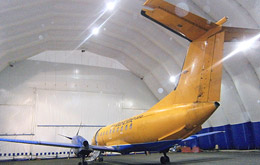
The frame of tension fabric buildings is made of aluminum trusses. The trusses are curved load-bearing arches made of high-quality aluminum, between which a tent membrane is placed. They are joined to a concrete foundation with their lower flanges.

The outer shell and inner tent consist of fragments that are fixed in the corresponding grooves of the neighboring aluminum trusses. Between the outer shell and inner tent, an insulation layer can be placed, which allows using the structures in the most severe climatic conditions.

The geometry of the profile of a tension fabric building presents vertical walls with a double pitch roof. The steep roof slope in combination with the antifriction material of the membrane can significantly reduce the snow load on the structure due to their ability to shed snow through sliding.
Aluminum frame

Aluminum trusses of tension fabric buildings are made by extrusion from АД31 alloy with subsequent hardening and artificial aging. This alloy belongs to the Avial alloy group, which is widely used in aircraft manufacturing. Aluminum is resistant to corrosion, ultraviolet radiation, and acid precipitation. The alloy is environmentally friendly - it does not emit any harmful substances, has no smell. Aluminum is lightweight. The strength of the alloy is 60% of that of the steel grade used for structures of this type, while the density of the aluminum alloy is only 35% of the density of this grade of steel. In practice, this means that the weight of a similar-strength aluminum structure is 1.6 times less than that of a steel one. Moreover, an aluminum profile has an almost unlimited service life.
Shell
The shell of Vector’s tension fabric buildings is made of a technical textile with a polymer coating. We offer several options of textiles with different properties.
1. Tent fabric.
The outer shell is made of high quality polyamide fabric with polyvinyl chloride (PVC) coating. The POLYMAR® 8205 fabric of the German company Mehler Texnologies is characterized by high strength, a wide range of operating temperatures (from -30 °C to +70 °C), high stain resistance, environmental safety. The lacquer coating of the outer layer, in combination with the steep roof slope, help reduce snow loads due to snow shedding.
2. Architectural fabric.
The outer shell is made of a Valmex PVC architectural membrane with a polyvinylidene fluoride coating. The membrane has all properties of a tent fabric and, due to the special PVDF coating, it is fire-retardant, highly durable and provides reliable protection against solar ultraviolet radiation. The Valmex fabric used is also characterized by antimicrobial properties.
3. Low friction architectural fabric.
The fabric is coated with polytetrafluoroethylene (PTFE), known as TEFLON. We recommend using a low friction architectural fabric for structures that are exposed to excessive snow loads, so that the snow does not linger on the roof of the structure.
Thermal envelope

The following design options for a tension fabric building are available:
- frame + outer shell
- frame + outer shell + inner tent
- frame + outer shell + inner tent + insulation layer.
To create the maximum thermal protection, we offer a thermal envelope, which consists of the following layers:
1) outer shell;
2) airspace;
3) layer of a foil thermal insulator (50 mm IZOVOL, with the thermal resistance equal to that of a 800 mm thick red brick wall);
4) airspace:
5) inner tent;
6) internal thermal insulation of the profile.
The thermal resistance of the envelope comprising all the mentioned layers is 8.1 m2 * K / W, which is equivalent to a 4.5 m thick red brick wall.
Footing
The structures are mounted on:
1. Strip foundation, with its minimum height determined by the depth of soil freezing and the minimum width of 500 mm.
2. Concrete plinths with fixings interconnected by grillage (with non-expansive soils).
Lighting
In the upper part of the shell, a light-transmitting structure - the so-called skylight – can be used. The skylight, placed in the center of the roof along the full length of the building, allows saving energy during daylight hours.
Creating indoor environment
Due to the excellent thermal insulation of our tension fabric buildings, the cost of their heating actually includes only that of the heating of the air coming in for ventilation. The amount of air required for the ventilation is calculated depending on the application of the building in each particular case.




 +35 988 202-55-57
+35 988 202-55-57
 Air supported
Air supported

 Inflatable
Inflatable

 Tension fabric
Tension fabric

 Canopies
Canopies





